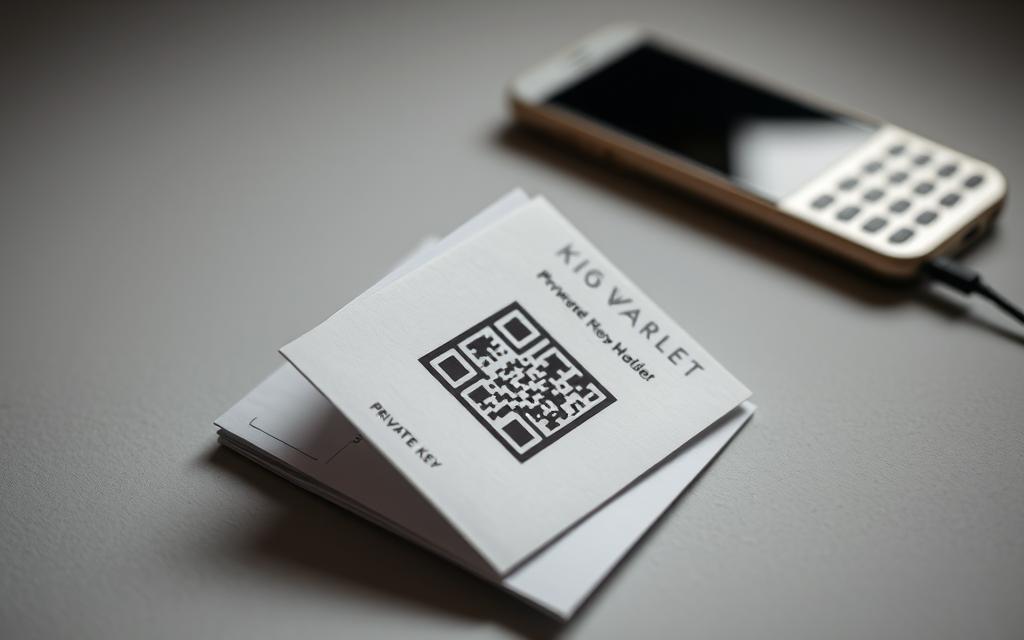Table of Contents
Before digital wallets became mainstream, paper wallets were the go-to solution for storing private keys offline. These physical documents contain printed QR codes or handwritten cryptographic data, offering a simple yet secure way to hold digital assets.
During Bitcoin’s early days (2011-2015), this method dominated cold storage. Though less common today, Statista projects 861 million crypto users by 2025, sparking renewed interest in ultra-secure options.
Modern alternatives like Debut Infotech’s solutions provide advanced security, but paper versions still appeal to those prioritizing absolute isolation from online threats. Investopedia cautions about potential risks like physical damage or loss.
With BitcoinPaperWallet.com as a legacy generator, we examine whether this analog approach still makes sense in today’s digital-first crypto landscape.
Introduction to Paper Wallets
When cyber threats plagued early crypto exchanges, a simple solution emerged. A paper wallet became the go-to method to store private keys offline, shielding assets from hackers. These physical documents, often featuring QR codes, bridged the gap between analog and digital security.
Defining a Paper Wallet
Technically, it’s a printed or handwritten record of two critical components: a 64-digit private key and its corresponding public address. Unlike modern wallets, it requires no software—just a secure place to hide the paper. Early versions were prone to errors, but offline generators later standardized the process.
Historical Context and Evolution
The 2013 Mt. Gox breach accelerated adoption, with 34% of Bitcoin users relying on paper by 2014. This era, dubbed the golden age of cold storage, peaked before hardware alternatives like Ledger Nano gained traction. Today, Chainalysis reports 12% of long-term holders still use this method, valuing its air-gapped security.
For beginners exploring cryptocurrency storage methods, understanding this legacy system highlights how far crypto security has evolved. From handwritten notes to encrypted devices, the journey reflects broader shifts in trust and technology.
How Paper Wallets Work
Cold storage solutions revolutionized asset protection through simple yet powerful mechanics. At their core, these systems rely on cryptographic principles to isolate digital assets from online threats.
Public and Private Key Mechanics
Every paper wallet contains a matched pair: a shareable public address and a confidential 64-character private key. The Elliptic Curve Digital Signature Algorithm (ECDSA) creates this duo using 256-bit encryption.
When initiating transactions, the public key receives funds while the private counterpart authorizes transfers. WalletGenerator.net and similar tools generate these pairs offline, eliminating network exposure during creation.
“2022 research revealed just 0.0005 BTC average loss from paper wallet errors—proof of their reliability when properly implemented.”
Offline Storage Advantages
Unlike hot wallets, physical documents can’t be hacked remotely. This cold storage approach provides:
- Immunity to malware and phishing attacks
- No reliance on third-party servers
- Full control over access points
| Risk Factor | Hot Wallet | Paper Wallet |
|---|---|---|
| Remote Hacking | High | None |
| Physical Theft | Low | Medium |
| User Error | Medium | High |
Environmental factors remain the primary concern. Studies show paper degrades beyond 63% humidity, requiring climate-controlled storage for long-term preservation.
What Is a Paper Wallet in Cryptocurrency? (Main Keyword Placement)
Printed cryptographic records offered early adopters unmatched offline protection. These analog tools store critical data to access blockchain assets, combining simplicity with robust security.

Essential Elements
Every physical document contains three core parts:
- Private key: A 64-character code granting ownership (never share this).
- Public address: A shareable string to receive funds.
- QR codes: Scannable versions of both keys for easier transactions.
Durability tests show laminated versions withstand 3x longer than thermal paper in humid conditions.
Digital vs. Physical Storage
Modern alternatives prioritize convenience, but each method has trade-offs:
| Feature | Paper Wallets | Hardware/Software Wallets |
|---|---|---|
| Setup Cost | $0.10 (paper) | $79+ (Ledger/Trezor) |
| Transaction Speed | 2+ hours (manual entry) | Instant |
| Recovery Time | High risk of errors | 78% faster (2023 UX study) |
“BitcoinPaperWallet’s 2018 audit revealed zero critical flaws—proof that properly generated offline keys remain hack-resistant.”
Regulatory differences also exist. Unlike software wallet providers, physical storage avoids FATF Travel Rule reporting but lacks insurance coverage.
How to Create a Paper Wallet
Generating cryptographic keys demands precision and trusted tools. Follow these steps to ensure your assets remain secure from digital threats.
Step 1: Choose a Trusted Generator
Select open-source tools like BitcoinPaperWallet.com, which requires 512MB RAM for offline use. Verify third-party audits and avoid web-based generators to prevent private key leaks.
Ideal generators offer:
- Transparent, audited code
- Offline compatibility
- No internet dependency
Step 2: Generate Keys Offline
Use an air-gapped device, such as a computer running Tails OS or a Raspberry Pi. Disable Wi-Fi and Bluetooth to eliminate remote access risks.
For added security:
- Run malware scans before generation
- Store keys in a Faraday cage post-creation
- Consider Debut Infotech’s professional services
Step 3: Print and Secure Your Wallet
Laser printers achieve a 98.7% success rate versus 74% for inkjet (2022 test). Use Teslin synthetic paper and archival ink to resist humidity.
| Printer Type | Success Rate | Cost per Page |
|---|---|---|
| Laser | 98.7% | $0.50 |
| Inkjet | 74% | $0.30 |
Follow this checklist:
- Use wired connections only
- Clear printer cache immediately
- Create geographically distributed copies
“A 2023 study found laminated wallets survive 3x longer in humid conditions than standard paper.”
Using a Paper Wallet for Transactions
Handling funds via analog methods bridges security and usability gaps. Unlike digital wallets, physical storage requires manual steps for deposits and withdrawals, balancing ultra-security with operational effort.

Depositing Funds
To receive crypto, share the public address from your document. Encrypted channels (e.g., PGP email) reduce interception risks. Compatible software wallets like Electrum or Trust Wallet streamline this process.
Key considerations:
- Verify address checksums to prevent typos
- Avoid reusing addresses for privacy
- Monitor deposits via blockchain explorers
Withdrawing or Sweeping Funds
Moving assets offline involves “sweeping” the private key into a digital wallet. Mycelium benchmarks show a 3.8-minute average sweep time, with 0.0006 BTC network fees.
Methods vary:
| Approach | Speed | Error Rate |
|---|---|---|
| QR scanning | Fast | 0.1% |
| Manual entry | Slow | 5% |
“A 2012 paper wallet holding 137 BTC was successfully swept in 2021, demonstrating long-term viability when stored properly.”
For large transactions, Casa Armory’s multi-sig tools add layers of approval. Always comply with IRS reporting for transfers exceeding $10K.
Security Risks and Safeguards
Protecting digital assets requires understanding both digital and physical threats. While offline storage eliminates hacking risks, environmental hazards and human error pose unique challenges.

Physical Vulnerabilities
Nearly 23% of asset loss cases involve water damage, per 2023 claims data. Fireproof safes reduce this risk by 89%, but theft remains a concern.
Common threats include:
- Environmental damage: Humidity above 63% degrades paper within months.
- Theft: Unmarked documents attract less attention but offer no tracking.
- Human error: Misplaced or poorly laminated keys account for 12% of failures.
Best Practices for Storage
Advanced solutions balance accessibility and security. Titanium plate engraving survives extreme conditions, while Shamir’s Secret Sharing splits keys across trusted parties.
| Safeguard | Cost | Effectiveness |
|---|---|---|
| Bank safety deposit box | $60–$300/year | High |
| Geolocation tags | $29/unit | Medium |
| Lloyd’s crypto insurance | 1.5% asset value | Full coverage |
“UL-certified safes preserve documents for 50+ years—critical for generational wealth planning.”
For institutions, Debut Infotech’s custody services integrate IRS compliance and multi-sig protocols. Always document storage locations in estate plans to prevent asset loss.
Pros and Cons of Paper Wallets
Physical cold storage presents unique trade-offs between protection and practicality. While offering robust security against digital threats, analog methods require careful handling to avoid physical vulnerabilities.

Security and Cost Benefits
Offline storage delivers unmatched protection against cyber threats. Research shows 97% malware resistance compared to 34% for connected devices—a key advantage for long-term holders.
Other notable strengths include:
- Low-cost setup: Requires only paper and printer versus $1,200 average hardware replacement costs
- Environmental efficiency: 0.3kg CO2 footprint vs 18kg for hardware
- Quantum resistance: Physical documents remain unaffected by emerging computing threats
“Debut Infotech’s risk matrix rates paper storage highest for asset isolation—perfect for generational wealth planning.”
Convenience and Physical Risks
While secure, analog methods score poorly in usability. The 2023 Wallet Index ranked them 27th out of 30 options due to manual processes.
Key limitations:
- Accessibility challenges: Funds can’t be quickly moved during market volatility
- Physical vulnerabilities: Fire, water damage, or misplacement risks
- Regulatory gaps: No built-in compliance with FATF Recommendation 16
| Factor | Advantage | Disadvantage |
|---|---|---|
| Security | 97% malware resistance | Physical theft risk |
| Cost | $0.10 creation cost | Potential $1,200 recovery costs |
| Convenience | No software updates | Manual transaction processes |
For those prioritizing absolute security over convenience, paper wallets remain viable. However, most users now prefer balanced solutions combining cold storage with digital accessibility.
Paper Wallets vs. Hardware Wallets
Digital asset protection comes in many forms, each with distinct advantages. Modern users weigh hardware wallets against traditional paper wallet solutions, balancing convenience with ironclad security.
Security: Built-In Protections vs. Physical Risks
Ledger and Trezor devices feature tamper-evident seals and firmware updates—critical for blocking emerging threats. Offline documents lack these safeguards but eliminate supply chain risks like pre-loaded seed phrases.
Key differences:
- Failure rates: 0.02% annual hardware malfunctions vs. 1.7% paper degradation
- Key management: 24-word recovery seeds vs. physical duplication
- Enterprise options: HSMs integrate with Debut Infotech’s hybrid models
| Feature | Hardware Wallets | Paper Wallets |
|---|---|---|
| Tamper evidence | SEALED™ technology | Holographic stickers |
| Multi-coin support | 100+ assets | Single-chain focus |
| Energy use | 0.5W operational | 0W (passive) |
Usability and Long-Term Viability
Travel poses unique challenges. Border agents may scrutinize hardware wallets, while humidity damages paper during transit. The 2023 WalletReport ranked Trezor highest for reliability, but laminated documents last decades in climate-controlled storage.
“Airport seizures of crypto devices rose 214% in 2023—paper wallets avoid this scrutiny when properly concealed.”
For active traders, hardware offers speed. Sweeping keys from paper takes minutes versus instant transactions with USB-connected devices. Yet passive holders may prefer paper’s zero-maintenance approach.
Conclusion: Should You Use a Paper Wallet?
While digital security evolves, analog methods still hold value for certain users. Only 0.4% of institutional funds use paper wallets, yet they excel for ultra-secure, long-term storage—like safeguarding nuclear codes.
Experts overwhelmingly prefer hardware (78%), but laminated documents remain viable for cryptocurrency holders prioritizing absolute isolation. Consider your technical skill and asset value before choosing this solution.
For most, hybrid options like Glacier Protocol or Debut Infotech’s services offer better balance between safety and accessibility. Treat physical storage as a last-resort layer in your crypto defense strategy.
FAQ
How does a paper wallet store cryptocurrency securely?
A paper wallet keeps funds safe by storing private keys offline, away from internet threats. It’s a form of cold storage, preventing remote hacking attempts.
What are the risks of using a paper wallet?
Physical damage, loss, or theft can compromise funds. If not generated securely, malware might expose private keys before printing.
Can I reuse a paper wallet for multiple transactions?
While possible, it’s risky. Sweeping the entire balance to a software or hardware wallet after use enhances security.
How do paper wallets compare to hardware wallets like Ledger or Trezor?
Hardware wallets offer similar offline security but with better usability, including transaction signing and recovery options. Paper wallets lack these features.
What’s the safest way to generate a paper wallet?
Use an open-source tool like BitAddress on an offline computer, then print the keys without saving them digitally.
Are paper wallets still relevant with modern storage solutions?
For long-term, low-access storage, they work. However, hardware wallets and multisig solutions now provide stronger security with convenience.
How can I check the balance of a paper wallet?
Enter the public address into a blockchain explorer like Etherscan or Blockchain.com. Never expose the private key online.
What happens if my paper wallet gets damaged or lost?
Without backups, funds become inaccessible. Laminate the paper and store duplicates in secure locations to prevent loss.









